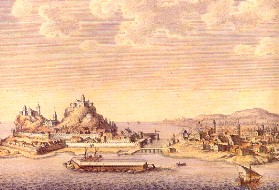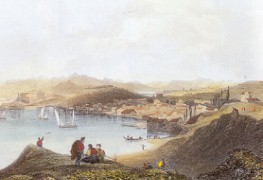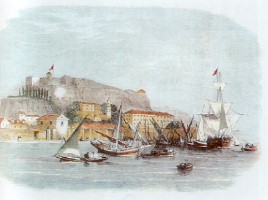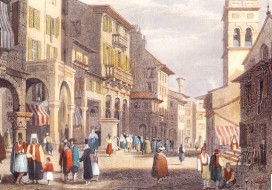|
 Corfu is mentioned frequently in Greek mythology . The
modern Greek name Kerkyra comes from the nymph who was the daughter of
the river-god Asopos . Posideon, the god of the sea fell in love with
her and made love to her on the island, giving birth to the race of the
Phaeacians. The name is also possibly linked to the demonic deity
Gorgyra or Gorgo, whose image was found on a pediment of the Archaic
Artemis temple. The more recent name Corfu is a corruption of koryphi,
which means peak, after the summit on which the Byzantines began
building a castle early in the 7th century, and where the main town was
later re-established. The name Kerkyra is only used in Greece; to the
rest of the world the island is known as Corfu, though the town is
universally called Kérkyra by preference. In The Odyssey , the
shipwrecked hero Odysseus is washed ashore with the help of the goddess
Athena and awakens to the laughter of princess Nausikaa and her friends
washing clothes in a nearby stream (widely thought to be somewhere on
the northwest coast, possibly at modern Érmones). They bring him to the
Phaeacian Palace and after revealing his identity to King Alkinoös
he is given a ship to take him safely back to Ithaka. However during
the return trip the Phaeacian ship is turned to stone by Posideon,
still enraged because Odysseus’ men had blinded Poseidon’s son the
Cylcops, in revenge for the Phaeacians helping Odysseus . Corfu is mentioned frequently in Greek mythology . The
modern Greek name Kerkyra comes from the nymph who was the daughter of
the river-god Asopos . Posideon, the god of the sea fell in love with
her and made love to her on the island, giving birth to the race of the
Phaeacians. The name is also possibly linked to the demonic deity
Gorgyra or Gorgo, whose image was found on a pediment of the Archaic
Artemis temple. The more recent name Corfu is a corruption of koryphi,
which means peak, after the summit on which the Byzantines began
building a castle early in the 7th century, and where the main town was
later re-established. The name Kerkyra is only used in Greece; to the
rest of the world the island is known as Corfu, though the town is
universally called Kérkyra by preference. In The Odyssey , the
shipwrecked hero Odysseus is washed ashore with the help of the goddess
Athena and awakens to the laughter of princess Nausikaa and her friends
washing clothes in a nearby stream (widely thought to be somewhere on
the northwest coast, possibly at modern Érmones). They bring him to the
Phaeacian Palace and after revealing his identity to King Alkinoös
he is given a ship to take him safely back to Ithaka. However during
the return trip the Phaeacian ship is turned to stone by Posideon,
still enraged because Odysseus’ men had blinded Poseidon’s son the
Cylcops, in revenge for the Phaeacians helping Odysseus .
|
|
 Artifacts from the Paleolithic period (40,000 to 30,000
BC) have been found in a cave at Gardíki in the southwestern part of
the island. There is also evidence of habitation during the Mesolithic
period and several Neolithic ( 6000–2600 BC) settlements have been
found including an important one near Sidári . During the Geometric
period, sometime before the 8th Century BC, the Illyrians (ancestors of
the modern Albanians) inhabited the island . The Greeks did not arrive
until around 750 BC, when the Euobean city of Eretria established a
colony here. In 734 BC the Eretrians were driven out by the
Corinthians, who brought great wealth and culture to the island, and
used it as a stepping-stone west for such ventures at the colonization
of Kroton in southern Italy. But in 665 BC Corfu fought with Corinth
, in what Thucydides described as the first sea battle in Greek
history. It was not the last battle between the two cities , who
remained at odds for centuries more . Corfu, now effectively
independent, prospered with trade and by the 6th Century was minting its
own coins, had constructed a fine Archaic temple of Artemis (source of
the famous Gorgon pediment) and had a population of over 10,000 people.
During the Persian Wars of the fifth century, Corfu had a fleet second
only to that of Athens . They sent a fleet of 60 ships to the Battle
of Salamis but according to Herodotos they took their time about
getting there to avoid the battle and were criticized by the Athenians.
In 433 BC , Corfu’s treaty of alliance with Athens against Sparta and
Corinth set off the Peloponnesian Wars, which engulfed all of the Greek
city-states, who were obliged to take the side of either Athens or
Sparta. The island lost half its population in these wars and
eventually fell to the Spartans. In 229 BC, the republican Romans
showed up and seized the island from Illyrian pirates, and for the next
five-and-a-half centuries Corfu was a privileged Roman naval base. Nero,
Tiberius, Cato, Cicero, Octavian (later Augustus) and Mark Anthony all
visited the island, and many wealthy Romans had estates here. From 395
AD to 1267 Corfu was part of the Byzantine Empire and suffered raids by
the Vandals and Ostrogoths, which prompted the gradual abandonment of
the ancient capital at the site now known as Paleópolis . Starting in
1080, Norman raiders from Sicily attacked (and briefly held) Corfu
several times, and when the forces of the Fourth Crusade captured
Constantinople in 1204, Corfu was nominally ceded to Venice. However,
they failed to occupy the island, which by 1214 had passed to Mihaïl
Angelos Komnenos II, head of the free Byzantine Despotate of Epiros,
based a Árta in western mainland Greece. During his tenure, the
previously existing fortresses at Angelókastro and Gardíki were
refurbished to defend against pirates or Latin invaders approaching from
the west. In 1259, Corfu was given to King Manfred of Sicily as the
partial dowry of Helena, daughter of Mihaïl Komnenos. Just 8 years
later, the island was formally annexed by Charles d’Anjou, the new King
of Sicily and Naples, whose Angevin dynasty then ruled Corfu for over a
century. They established Roman Catholicism as the official religion,
displacing the Byzantine Orthodox clergy. Artifacts from the Paleolithic period (40,000 to 30,000
BC) have been found in a cave at Gardíki in the southwestern part of
the island. There is also evidence of habitation during the Mesolithic
period and several Neolithic ( 6000–2600 BC) settlements have been
found including an important one near Sidári . During the Geometric
period, sometime before the 8th Century BC, the Illyrians (ancestors of
the modern Albanians) inhabited the island . The Greeks did not arrive
until around 750 BC, when the Euobean city of Eretria established a
colony here. In 734 BC the Eretrians were driven out by the
Corinthians, who brought great wealth and culture to the island, and
used it as a stepping-stone west for such ventures at the colonization
of Kroton in southern Italy. But in 665 BC Corfu fought with Corinth
, in what Thucydides described as the first sea battle in Greek
history. It was not the last battle between the two cities , who
remained at odds for centuries more . Corfu, now effectively
independent, prospered with trade and by the 6th Century was minting its
own coins, had constructed a fine Archaic temple of Artemis (source of
the famous Gorgon pediment) and had a population of over 10,000 people.
During the Persian Wars of the fifth century, Corfu had a fleet second
only to that of Athens . They sent a fleet of 60 ships to the Battle
of Salamis but according to Herodotos they took their time about
getting there to avoid the battle and were criticized by the Athenians.
In 433 BC , Corfu’s treaty of alliance with Athens against Sparta and
Corinth set off the Peloponnesian Wars, which engulfed all of the Greek
city-states, who were obliged to take the side of either Athens or
Sparta. The island lost half its population in these wars and
eventually fell to the Spartans. In 229 BC, the republican Romans
showed up and seized the island from Illyrian pirates, and for the next
five-and-a-half centuries Corfu was a privileged Roman naval base. Nero,
Tiberius, Cato, Cicero, Octavian (later Augustus) and Mark Anthony all
visited the island, and many wealthy Romans had estates here. From 395
AD to 1267 Corfu was part of the Byzantine Empire and suffered raids by
the Vandals and Ostrogoths, which prompted the gradual abandonment of
the ancient capital at the site now known as Paleópolis . Starting in
1080, Norman raiders from Sicily attacked (and briefly held) Corfu
several times, and when the forces of the Fourth Crusade captured
Constantinople in 1204, Corfu was nominally ceded to Venice. However,
they failed to occupy the island, which by 1214 had passed to Mihaïl
Angelos Komnenos II, head of the free Byzantine Despotate of Epiros,
based a Árta in western mainland Greece. During his tenure, the
previously existing fortresses at Angelókastro and Gardíki were
refurbished to defend against pirates or Latin invaders approaching from
the west. In 1259, Corfu was given to King Manfred of Sicily as the
partial dowry of Helena, daughter of Mihaïl Komnenos. Just 8 years
later, the island was formally annexed by Charles d’Anjou, the new King
of Sicily and Naples, whose Angevin dynasty then ruled Corfu for over a
century. They established Roman Catholicism as the official religion,
displacing the Byzantine Orthodox clergy.
|
|
 In 1386, viewing Angevin decline (and increasing pirate
raids) with alarm, the island notables essentially invited the
Venetians to assume control of Corfu, which they did until 1797 . This
was probably the most important period for the island, not only because
of the economic progress – primarily the introduction of over 3 million
olive trees – and the ongoing program of urban and military
construction, but also because it was during this period that the rest
of Greece fell under the domination of the Ottoman Turks. The main town
became a fortress and an important base for the Venetian fleet, while
Corfu overall served as a place of refuge for many Greek scholars and
artists escaping Ottoman-conquered territory, in particular Crete after
the mid-17th century, making the island one of the most culturally
developed regions in the eastern Mediterranean . In 1386, viewing Angevin decline (and increasing pirate
raids) with alarm, the island notables essentially invited the
Venetians to assume control of Corfu, which they did until 1797 . This
was probably the most important period for the island, not only because
of the economic progress – primarily the introduction of over 3 million
olive trees – and the ongoing program of urban and military
construction, but also because it was during this period that the rest
of Greece fell under the domination of the Ottoman Turks. The main town
became a fortress and an important base for the Venetian fleet, while
Corfu overall served as a place of refuge for many Greek scholars and
artists escaping Ottoman-conquered territory, in particular Crete after
the mid-17th century, making the island one of the most culturally
developed regions in the eastern Mediterranean .
In 1537 Hayreddin Barbarossa, a pirate-admiral in the service of
Sultan Süleyman the Magnificent, laid siege to the town with artillery
and 20,000 troops. The Corfiots managed to repel Barbarossa, but not
before he carried off nearly half the population to be sold as slaves .
After this, the Venetians decided to build the New Fortress, and dug a
channel (the Contrafossa) to effectively make the Old Fortress an island
. These all came in handy in summer 1716 when the Ottomans made their
most determined effort yet to take Corfu, with a force of 30,000 poised
to overwhelm just 8,000 defenders under the command of German mercenary
Johan Matthias von der Schulenberg (whose statue now stands near the
gate of the Old Fortress). The Ottomans suddenly abandoned their siege
on 11 August, after an apparition of island patron saint Spyridon, and a
ferocious storm (supposedly conjured by him) – the date is one of
Spyridon’s several annual local celebrations .
|
|
When the Napoleonic French occupied the island in 1797, the Corfiots
initially welcomed them with enthusiasm, believing that French
revolutionary principles meant that the lower classes would be treated
better than under Venetian rule . But this was not the case. The French
imposed heavy taxes on the people, though they did introduce a system of
primary education and a printing house. But two years later a combined
Russian and Turkish fleet captured the island after four months of
fighting, and Corfu became the capital of the puppet Septinsular
Republic which included all the Ionian islands. Then in 1807 when Russia
and France signed the Treaty of Tilsit, Corfu and the other Ionian
islands once again reverted to Napoleon . This time around the French
took more of an interest in local development, establishing the first
Ionian Academy, importing printing presses and introducing new crops
like potatoes and tomatoes.
 When Napoleon fell in 1814 Corfu was placed under the protection of the
British. The Corfiot Ioannis Kapodistrias, long a diplomat in the
service of Russia (and an important figure in the Septinsular Republic
), submitted a proposal at the Congress of Vienna for an independent
Ionian state, but Britain, Austria and Prussia vetoed it. But the 1815
Congress of Paris did set up a United States of the Ionian Islands with
Corfu as its capital, administered under a British High Commissioner.
Kapodistrias became the first president of independent Greece in 1827,
though he was assassinated in 1831. In 1824 the second Ionian Academy,
essentially the first Greek university, was established. After years of
autocratic British rule, 1848 saw a revised local constitution that
granted freedom of the press, recognized Greek as the official
language and introduced educational reform. Despite ongoing tension
between British administrators and the Corfiots – the first high
commissioner, Tom Maitland, was nicknamed “The Abortion” locally for his
rudeness to petitioners and refusal to wash – status as a British
colony was responsible for the building of the roads and the creation
of the island's water supply.The Ionian islands did not become a part
of Greece until 1864, as a primary condition for George I (born the
young Danish prince William Glucksberg) to ascend the Greek throne . When Napoleon fell in 1814 Corfu was placed under the protection of the
British. The Corfiot Ioannis Kapodistrias, long a diplomat in the
service of Russia (and an important figure in the Septinsular Republic
), submitted a proposal at the Congress of Vienna for an independent
Ionian state, but Britain, Austria and Prussia vetoed it. But the 1815
Congress of Paris did set up a United States of the Ionian Islands with
Corfu as its capital, administered under a British High Commissioner.
Kapodistrias became the first president of independent Greece in 1827,
though he was assassinated in 1831. In 1824 the second Ionian Academy,
essentially the first Greek university, was established. After years of
autocratic British rule, 1848 saw a revised local constitution that
granted freedom of the press, recognized Greek as the official
language and introduced educational reform. Despite ongoing tension
between British administrators and the Corfiots – the first high
commissioner, Tom Maitland, was nicknamed “The Abortion” locally for his
rudeness to petitioners and refusal to wash – status as a British
colony was responsible for the building of the roads and the creation
of the island's water supply.The Ionian islands did not become a part
of Greece until 1864, as a primary condition for George I (born the
young Danish prince William Glucksberg) to ascend the Greek throne .
Early years as a Greek province were uneventful for
Corfu, other than being a favourite resort for European royalty such as
Empress Elisabeth of Austria and Kaiser Wilhelm II of Germany. Although
royalist Greece was neutral during the first three years of World War I,
Corfu declared for the Venizelist Republicans in the civil war which
effectively divided the country from 1916 onwards. Early that year, the
exiled government of Serbia and its retreating army, having been driven
into Albania by the Bulgarians and Austrians, found shelter on the
island, the beginning of a long love affair between Serbia and Greece;
within several months, 130,000 Serbian solders were well enough to be
sent on British and French ships to fight the Bulgarians and Germans on
the Salonika Front, but almost 20,000 more died of wounds or disease on
the island, or stayed to marry local women. Corfu was bombarded and
briefly occupied by the Italians in September 1923, in reprisal for the
Greek murder of an Italian general on the Greek-Albanian frontier; the
Italians returned as occupiers during World War II, until displaced in
September 1943 by the Germans, who not only bombed much of Kérkyra Town
flat in the process, but deported most of the 1900 local Jews to their
deaths in June 1944 before the Allied victory in Greece four months
later.
Modern tourism began with the opening of a Club Med
premises near Ýpsos in 1952, followed by the arrival of the first
charters from overseas in 1972 – and the construction of the first
mega-hotels by those with good connections in the ruling military junta.
Tourism, and more recently real estate sales, have long displaced
agriculture as the main economic activity, though both are suffering
sharply (and having to adapt) in the current world crisis. All-inclusive
resorts for eastern Europeans are on the rise, with numbers of Brits,
Italians and Germans in decline. It’s currently a buyer’s market for
property which is simply not moving in prevailing conditions.
|
|
For more on Greek History see www.ahistoryofgreece.com
|
|